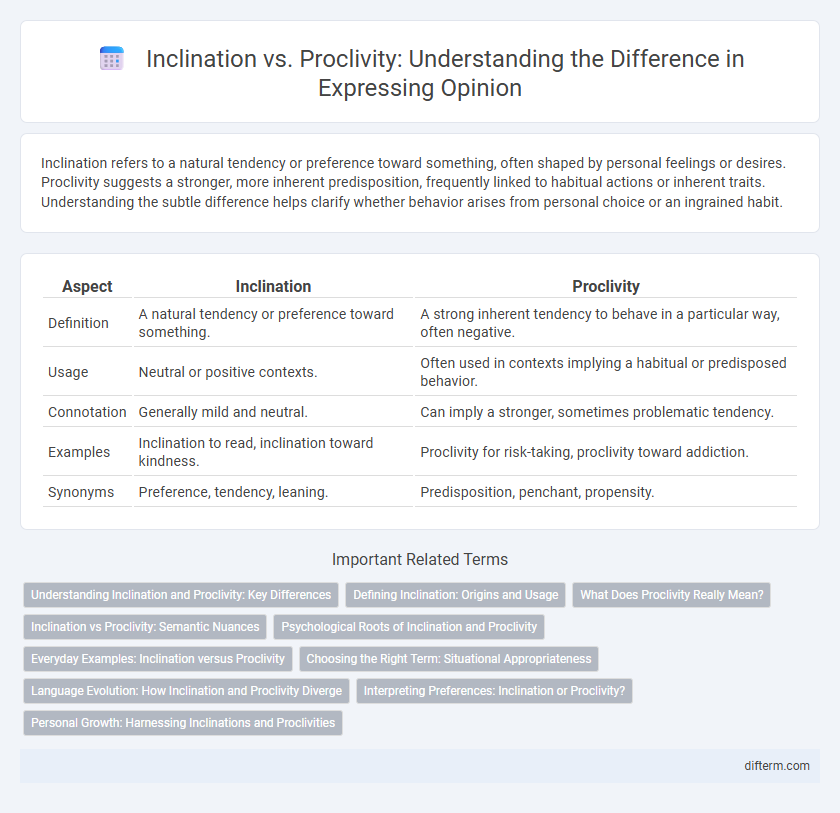Inclination refers to a natural tendency or preference toward something, often shaped by personal feelings or desires. Proclivity suggests a stronger, more inherent predisposition, frequently linked to habitual actions or inherent traits. Understanding the subtle difference helps clarify whether behavior arises from personal choice or an ingrained habit.
Table of Comparison
| Aspect | Inclination | Proclivity |
|---|---|---|
| Definition | A natural tendency or preference toward something. | A strong inherent tendency to behave in a particular way, often negative. |
| Usage | Neutral or positive contexts. | Often used in contexts implying a habitual or predisposed behavior. |
| Connotation | Generally mild and neutral. | Can imply a stronger, sometimes problematic tendency. |
| Examples | Inclination to read, inclination toward kindness. | Proclivity for risk-taking, proclivity toward addiction. |
| Synonyms | Preference, tendency, leaning. | Predisposition, penchant, propensity. |
Understanding Inclination and Proclivity: Key Differences
Inclination refers to a person's natural tendency or preference toward certain behaviors or choices, often shaped by personal feelings or desires. Proclivity indicates a stronger, often innate predisposition toward specific actions or habits, implying a more consistent and enduring trait. Understanding the key differences between inclination and proclivity helps clarify how temporary preferences differ from deep-seated tendencies in human behavior analysis.
Defining Inclination: Origins and Usage
Inclination stems from the Latin inclinatio, meaning a bending or leaning toward something, often describing a natural tendency or preference in behavior and thought. It typically conveys a gentle, often subconscious, leaning that influences decisions without strong compulsion or obligation. Usage of inclination varies across disciplines, from psychology, where it describes latent desires, to everyday language expressing mild preference or interest.
What Does Proclivity Really Mean?
Proclivity refers to a natural or habitual inclination toward a particular behavior or activity, often implying an innate or deep-seated tendency. Unlike inclination, which can be temporary or situational, proclivity emphasizes a consistent and enduring predisposition. Understanding proclivity requires recognizing the intrinsic motivation that compels individuals toward specific actions or preferences.
Inclination vs Proclivity: Semantic Nuances
Inclination and proclivity both describe a tendency to behave in a certain way, but inclination implies a milder, often conscious preference or feeling, while proclivity suggests a stronger, sometimes innate or habitual predisposition. Semantic nuances reveal that inclination is linked more to personal choice or feeling, whereas proclivity emphasizes an underlying natural or habitual drive. Understanding these subtleties enhances clarity in expressing psychological or behavioral tendencies with precision.
Psychological Roots of Inclination and Proclivity
Psychological roots of inclination often stem from intrinsic motivations and early experiences that shape personal preferences and emotional responses. Proclivity, by contrast, refers to a stronger, sometimes innate or habitual tendency towards specific behaviors, influenced by genetic predispositions and reinforced through repeated actions. Understanding these distinctions highlights how inclination reflects more fluid and situational preferences, while proclivity indicates deeper, potentially hardwired behavioral patterns in psychological frameworks.
Everyday Examples: Inclination versus Proclivity
Inclination refers to a natural tendency or preference towards something, such as a person's inclination to enjoy reading novels in their leisure time. Proclivity implies a stronger, often habitual or innate predisposition, like a proclivity for problem-solving that drives someone to pursue careers in engineering or mathematics. Everyday, recognizing the difference helps clarify whether a behavior is simply a preference or a more deeply rooted, consistent pattern.
Choosing the Right Term: Situational Appropriateness
Choosing between "inclination" and "proclivity" depends on the context and the degree of natural tendency implied. "Inclination" often refers to a mild or general preference, suitable for casual or less intense situations, while "proclivity" denotes a stronger, often innate or habitual tendency, frequently used in more formal or psychological contexts. Selecting the appropriate term enhances precision and clarity, aligning the expression with the intended nuance and audience expectations.
Language Evolution: How Inclination and Proclivity Diverge
Inclination and proclivity diverge notably in language evolution through their nuanced semantic shifts; inclination often conveys a gentler, more conscious tendency, whereas proclivity implies a stronger, almost innate predisposition. This distinction reflects broader linguistic trends where subtle differences in word usage capture varying degrees of intentionality and natural propensity. Understanding these shifts enhances comprehension of how language adapts to express complex human behaviors with increasing precision.
Interpreting Preferences: Inclination or Proclivity?
Interpreting preferences requires distinguishing between inclination, which implies a mild or natural tendency toward something, and proclivity, denoting a stronger, often habitual predilection. Inclination suggests a softer, sometimes temporary preference influenced by emotions or circumstances, while proclivity indicates a deeper, more persistent behavioral pattern shaped by inherent traits or repeated experiences. Understanding this nuance clarifies how preferences shape decisions, highlighting the difference between momentary leanings and enduring propensities.
Personal Growth: Harnessing Inclinations and Proclivities
Inclination refers to a natural tendency or preference toward a particular behavior, while proclivity implies a stronger, often innate predisposition. Harnessing these personal inclinations and proclivities can accelerate personal growth by aligning actions with authentic motivations. Recognizing the subtle difference enhances self-awareness and fosters intentional development paths.
inclination vs proclivity Infographic

 difterm.com
difterm.com